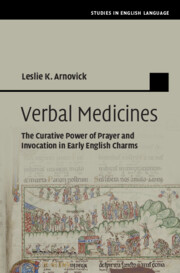Book contents
- Verbal Medicines
- Studies in English Language
- Verbal Medicines
- Copyright page
- Contents
- Figures
- Tables
- Introduction
- Chapter 1 Invoking Baptism
- Chapter 2 Psalm Charms as Aids against Illness
- Chapter 3 Invoking the Name of Mary
- Chapter 4 Invoking the Visitation of the Sick
- Chapter 5 The Multiplier Effect
- Chapter 6 Theoretical Implications
- Notes
- References
- Index
Chapter 2 - Psalm Charms as Aids against Illness
Published online by Cambridge University Press: 29 November 2024
- Verbal Medicines
- Studies in English Language
- Verbal Medicines
- Copyright page
- Contents
- Figures
- Tables
- Introduction
- Chapter 1 Invoking Baptism
- Chapter 2 Psalm Charms as Aids against Illness
- Chapter 3 Invoking the Name of Mary
- Chapter 4 Invoking the Visitation of the Sick
- Chapter 5 The Multiplier Effect
- Chapter 6 Theoretical Implications
- Notes
- References
- Index
Summary
The praying of psalms is the subject of Chapter 2. Psalms are frequently sung in charm rituals. They are carefully prescribed to help heal human and animal illness. Acute and painful diseases, such as diarrhea and carbuncles, are treated with psalms, as is fever. Even madness and “fiend-sickness” might respond to them, it was hoped. Psalms have great resonance for the English. They lie at the core of medieval liturgies, both monastic and public. They give hope to the suffering during the Visitation of the Sick. They were offered more generally as personal prayers and as penance. Chapter two establishes the petitionary nature of the psalms used in charm remedies. It demonstrates how psalms structure and organize charm performance with regard to other incantations. Psalms serve as practical prayers, the functionality of which arises out of each psalm’s generic form. They seek God’s assistance by asking the Lord directly or indirectly for aid. Psalms that use figurative language relevant to a charm’s objective employ metaphor and simile that act as vehicles for sympathetic magic. Charms render psalm incantations as powerful medicine for those in need.
Keywords
- Type
- Chapter
- Information
- Verbal MedicinesThe Curative Power of Prayer and Invocation in Early English Charms, pp. 79 - 110Publisher: Cambridge University PressPrint publication year: 2024

